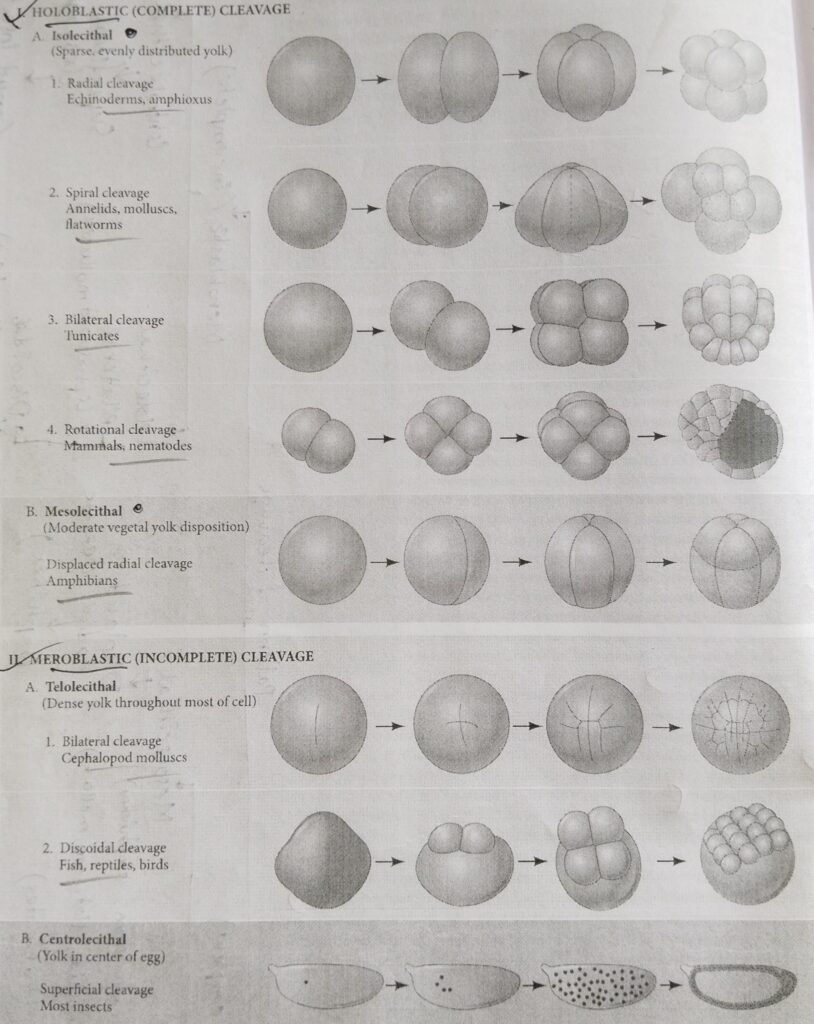Table of Contents
Two major parameters determine the patterns of cleavage: 1) the amount and distribution of yolk protein within the cytoplasm, which determines where cleavage can occur and the relative sizes of the blastomeres, and 2) factors in the egg cytoplasm that influence the angle of the mitotic spindle and the timing of its formation.
Patterns of cleavage
In general, yolk inhibits cleavage. When one pole of a egg is relatively yolk-free, cellular divisions occur there at a faster rate than at the positive pole. The yolk-rich pole is referred to as the vegetal pole; the yolk concentration is comparatively low at the animal pole.
The chart of patterns of cleavage with examples:

Holoblastic cleavage
At one extreme are the eggs of sea urchins, mammals, and snails. These eggs have sparse, equally distributed yolk and are thus isolecithal. In these species cleavage is holoblastic. This means the cleavage furrow extends through the entire egg. With the little yolk, these embryos must have some other way of obtaining food.
Most will generate a voracious larval form, while mammals will obtain their nutrition from the maternal placenta.
Meroblastic cleavage
At the other extreme are the eggs of insects, fish, reptiles, and birds. Most of their cell volumes are made up of yolk. The yolk must be sufficient to nourish these animals throughout embryonic development. Zygotes containing large accumulation of yolk undergo meroblastic cleavage, wherein only a portion of the cytoplasm is cleaved.
The cleavage furrow does not penetrate the yolky portion of the cytoplasm because the yolk platelets impede membrane formation there. Insect eggs have yolk in the center- known as centrolecithal eggs.
The divisions of the cytoplasm occur only in the rim of the cytoplasm, around the periphery of the cell- known as superficial cleavage.
The eggs of birds and fish have only one small area of the egg that is free of yolk – known as telolecithal eggs, therefore the cell divisions occur only in this small disc of cytoplasm, giving rise to discoidal cleavage.
Yolk is just one factor influencing a species’ patterns of cleavage. There are also, as Conklin has intuited, inherited patterns of cell divisions superimposed on the constraints of the yolk. The importance of this inheritance can readily be seen in isolecithal eggs. In the absence of a large concentration of yolk, holoblastic cleavage takes place. Four major patterns of this cleavage type can be described into four types. These are radial, spiral, bilateral, and rotational holoblastic cleavage.
Summary of the patterns of cleavage with examples and diagrams:

Other related notes:
- Cell cycle checkpoints: https://thebiologyislove.com/cell-cycle-checkpoints/
- Gamete fusion and the prevention of polyspermy: https://thebiologyislove.com/gamete-fusion-the-prevention-of-polyspermy/
Facebook link: https://www.facebook.com/share/p/ddZzxfvumtYxXAnK/?mibextid=oFDknk
The note reference is the developmental biology book by Gilbert.

